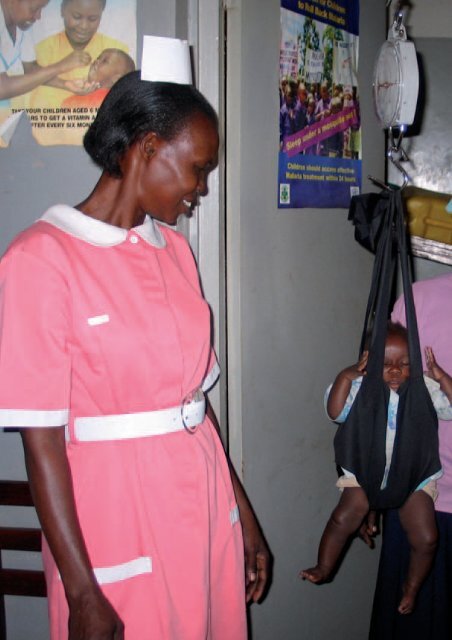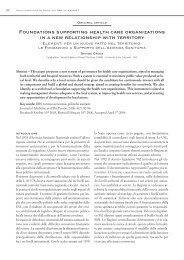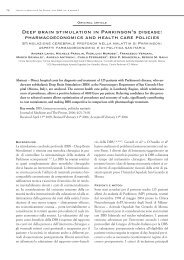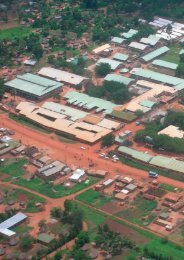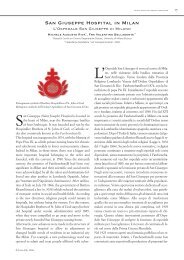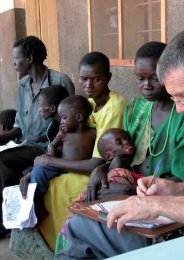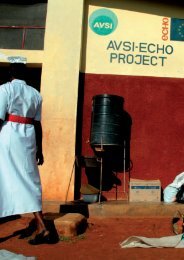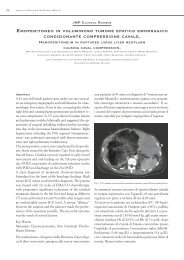Kitgum District - Journal of Medicine and the Person
Kitgum District - Journal of Medicine and the Person
Kitgum District - Journal of Medicine and the Person
Create successful ePaper yourself
Turn your PDF publications into a flip-book with our unique Google optimized e-Paper software.
<strong>Kitgum</strong> <strong>District</strong><br />
Government<br />
Hospital<br />
Year <strong>of</strong> Foundation: 1934<br />
Management: Ministry <strong>of</strong> Health <strong>of</strong> Ug<strong>and</strong>a<br />
Number <strong>of</strong> beds: 208<br />
Staff: 148<br />
Medical Officers: 4<br />
Outpatients 2004/05: 102.781<br />
Inpatients 2004/05: 9.848<br />
Inpatient Mortality: 3,3%<br />
Children’s Mortality: 3,2%<br />
Average Length Of hospital Stay: 8 days<br />
Bed Occupancy Rate: 95%<br />
Background<br />
<strong>Kitgum</strong> <strong>District</strong> Hospital is <strong>the</strong> <strong>of</strong>ficial government<br />
hospital for <strong>Kitgum</strong> <strong>District</strong>. It was founded<br />
under <strong>the</strong> British Protectorate in 1934 as part<br />
<strong>of</strong> an integrated national health System. It is also<br />
<strong>the</strong> site <strong>of</strong> a military ward for <strong>the</strong> care <strong>of</strong> soldiers<br />
controlling <strong>the</strong> district <strong>and</strong> exposed to<br />
guerrilla actions.<br />
AVSI has a long history <strong>of</strong> presence in this hospital<br />
since <strong>the</strong> 1970s, streng<strong>the</strong>ned by <strong>the</strong> support<br />
given during <strong>the</strong> last 20 years ravaged by<br />
<strong>the</strong> war.
Context <strong>and</strong> Location<br />
<strong>Kitgum</strong> <strong>District</strong> Hospital is located within <strong>the</strong> town council area, 3 km away from <strong>Kitgum</strong> Mission where St.<br />
Joseph’s Hospital is <strong>and</strong> constitutes <strong>the</strong> Health Sub <strong>District</strong> s <strong>of</strong> Chua County. It covers an area <strong>of</strong> about<br />
7.557 square kilometres, with 80% <strong>of</strong> <strong>the</strong> l<strong>and</strong> being arable. The vegetation is savannah predominantly flat<br />
fertile l<strong>and</strong> with gentle slopes becoming hilly towards <strong>the</strong> North to <strong>the</strong> Sudan border. The district is predominantly<br />
inhabited by <strong>the</strong> Acholi tribe. The total population by mid 2005 is estimated to be 317.107 with<br />
an annual growth rate <strong>of</strong> 4,19%. The females constitute 52% <strong>of</strong> <strong>the</strong> total population, children under-5 years<br />
<strong>the</strong> 18% (Ug<strong>and</strong>a Population <strong>and</strong> Housing Census, 2002). Currently nearly all <strong>the</strong> rural population, an estimated<br />
310.000 people is displaced in 21 IDP camps (OCHA – Ug<strong>and</strong>a October 2005). The community life<br />
style has been interrupted by <strong>the</strong> prolonged insecurity in <strong>the</strong> area <strong>and</strong> <strong>the</strong> family structure is broken down.<br />
The disease burden in <strong>the</strong> community is mainly communicable <strong>and</strong> <strong>the</strong>refore preventable diseases. The<br />
five top causes <strong>of</strong> morbidity are malaria, acute respiratory infections, intestinal worms, skin diseases <strong>and</strong><br />
pneumonia. More than half <strong>of</strong> <strong>the</strong> morbidity in <strong>the</strong> OPD in all health facilities is among <strong>the</strong> under five.<br />
The recent Health <strong>and</strong> Mortality Survey among Internally Displaced <strong>Person</strong>s conducted by WHO in collaboration<br />
with o<strong>the</strong>r partners shows worse figures than <strong>the</strong> above. Because <strong>of</strong> <strong>the</strong> prolonged period <strong>of</strong> civil<br />
strife minimum IDP services st<strong>and</strong>ards are very far from being met.<br />
Hospital Mission<br />
The attainment <strong>of</strong> a good st<strong>and</strong>ard <strong>of</strong> health by all <strong>the</strong> people in Ug<strong>and</strong>a, in order to promote a healthy <strong>and</strong><br />
productive life.
Kigtum <strong>District</strong> Government Hospital 49<br />
HOSPITAL PROFILE<br />
The total number <strong>of</strong> beds, 208, has remained stable for <strong>the</strong> past 3 financial years. The medical <strong>and</strong> surgical<br />
wards are mixed <strong>and</strong> distributed as male <strong>and</strong> female ward. There is a paediatric ward, a maternity ward,<br />
a TB ward <strong>and</strong> a military ward managed directly by military health workers. There is no nutrition unit but<br />
a Supplementary Feeding Centre.<br />
Ward<br />
N. <strong>of</strong> beds<br />
Medical 58<br />
Surgical 22<br />
Paediatric 42<br />
Maternity 39<br />
TB 25<br />
Military 22<br />
Table 1. Hospital Wards <strong>and</strong> beds<br />
Figure 1. OPD trend <strong>of</strong> contacts in <strong>the</strong> last 3 financial years<br />
Outpatient Services<br />
The Outpatient department is open Monday to Friday until 5 pm <strong>and</strong> on Saturdays morning. It includes<br />
Dental <strong>and</strong> Eye services provided by clinical <strong>of</strong>ficers. Daily contacts are about 200 per day during dry season,<br />
400 per day during rain season. Clinical Officers recruited through ECHO were posted to OPD<br />
where <strong>the</strong>y screen patients <strong>and</strong> send referrals directly to wards for medical <strong>of</strong>ficers’ review.<br />
© Punto Effe, 2006
50<br />
SUPPLEMENT NUMBER 1, JOURNAL OF MEDICINE & THE PERSON. JUNE 2006, VOL. 4<br />
2002-03 2003-04 2004-05<br />
New attendances 0-4years 27.252 24.088 22.995<br />
New attendances 5 years <strong>and</strong> over 40.420 46.497 51.354<br />
Total new attendances 67.672 70.585 74.349<br />
Re-attendances 0-4 years 8.365 9.157 8.136<br />
Re-attendances 5 years <strong>and</strong> over 18.202 23.280 20.296<br />
total Re-attendances 26.567 32.437 28.432<br />
TOTAL 94.239 103.022 102.781<br />
Table 2. OPD attendance in <strong>the</strong> last 3 financial years.<br />
Figure 2. Leading OPD diagnoses among patients > 5 years in <strong>the</strong> last 3 financial years.<br />
Despite remaining one <strong>of</strong> <strong>the</strong> busier OPD’s in <strong>the</strong> region, <strong>Kitgum</strong> like Gulu Regional Referral Hospital has<br />
seen a slight decline in OPD attendance in <strong>the</strong> last year due to <strong>the</strong> under 5 years old attendance, while it is<br />
slightly increasing <strong>the</strong> 5 years <strong>and</strong> older attendance. This is analyzed in relation to St. Joseph’s hospital<br />
(which shows an increase in both younger <strong>and</strong> older age groups for <strong>the</strong> same period). Not differently from<br />
Gulu, <strong>the</strong> drift <strong>of</strong> children towards St. Joseph’s Hospital is associated with <strong>the</strong> reduction in user fees. The<br />
opening <strong>of</strong> some nearby health centres that were previously closed is ano<strong>the</strong>r possible explanation. O<strong>the</strong>r<br />
reasons difficult to prove because <strong>the</strong>y did not change in <strong>the</strong> last two years, are a preference for care at St.<br />
Joseph’s, or that <strong>the</strong>re may be drug shortages at <strong>Kitgum</strong>.
Kigtum <strong>District</strong> Government Hospital 51<br />
Figure 3. Leading OPD diagnoses among patients < 5 years in <strong>the</strong> last 3 financial years.<br />
Figure 4. Leading causes <strong>of</strong> admission in children in <strong>the</strong> last 3 financial years.<br />
© Punto Effe, 2006
Figure 5. Leading causes <strong>of</strong> admission in adults in <strong>the</strong> last 3 financial years.<br />
Inpatients<br />
The total inpatient number considerably diminished as compared to 2003-04 from 11.301 to 9.096, but<br />
Case Fatality Rate (CFR) was also reduced to 3,3% from 5,3% <strong>of</strong> <strong>the</strong> previous year when <strong>the</strong> increase <strong>of</strong><br />
workload from 2002-03 (9.466 patients) was probably hard to h<strong>and</strong>le <strong>and</strong> raised CFR from 4,5% <strong>of</strong> 2002-<br />
03. Numbers <strong>of</strong> admissions reduced in particular for children’s ward where <strong>the</strong> shift was probably towards<br />
St. Joseph’s that increased admissions in <strong>the</strong> same age group. At <strong>the</strong> same time quality <strong>of</strong> care improved<br />
with smaller number <strong>of</strong> patients, with case fatality rate equalling that <strong>of</strong> St. Joseph’s at 3,16%. This might<br />
be considered as a good indicator <strong>of</strong> integration between <strong>the</strong> two hospitals in <strong>the</strong> field <strong>of</strong> management <strong>of</strong><br />
children’s illness. Maternity ward was <strong>the</strong> only one to increase slightly its number <strong>of</strong> admitted patients<br />
(2.697 with 2.305 deliveries). In o<strong>the</strong>r words, one can hardly draw any conclusions about <strong>the</strong> ward activity<br />
except for maternity/gynaecology <strong>and</strong> paediatrics. The children’s ward decrease well correlates with <strong>the</strong><br />
reduced outpatient activity.<br />
HOSPITAL STAFF<br />
Currently <strong>the</strong>re are 4 Medical Officers employed by Kigtum <strong>District</strong> Government Hospital including <strong>the</strong><br />
Medical Superintendent who contributes to <strong>the</strong> clinical activity <strong>of</strong> medical ward. One medical <strong>of</strong>ficer is<br />
present in Surgical, Maternity <strong>and</strong> Children’s ward.<br />
Medical ward is mainly staffed by 2 Clinical Officers. Among qualified personnel <strong>the</strong>re is also 1 or-
Kigtum <strong>District</strong> Government Hospital 53<br />
thopaedic <strong>of</strong>ficer (supported by ECHO funding) <strong>and</strong> 1 anaes<strong>the</strong>tic <strong>of</strong>ficer, 4 laboratory technicians, 13<br />
Clinical Officers.<br />
ECHO employed fur<strong>the</strong>r 2 Clinical Officers. There are 12 Nursing Officers, 24 Enrolled Nurses plus 3 additional<br />
under ECHO, 16 Enrolled Midwives <strong>and</strong> 2 with ECHO, 21 Nursing Aides. Administrative <strong>and</strong><br />
support staff is 14 with 4 additional under ECHO: namely Medical Social worker, mortuary attendant,<br />
plumber, <strong>and</strong> gatekeeper.<br />
AVSI-ECHO Interventions<br />
in KITGUM GOVERNMENT HOSPITAL<br />
ECHO Ug<strong>and</strong>a 4 PROJECT: OCTOBER 2002 TO JANUARY 2003.<br />
BUDGET: 78.200.000 Ug<strong>and</strong>a Shillings (40.600 Euro)<br />
• Supply <strong>and</strong> transport <strong>of</strong> drugs, sundries <strong>and</strong> equipment<br />
• Construction <strong>of</strong> a shelter for night commuters <strong>and</strong> water tank<br />
• Construction <strong>of</strong> pit latrines<br />
• New generator <strong>and</strong> fuel for <strong>the</strong> hospital<br />
ECHO Ug<strong>and</strong>a 5 PROJECT: FEBRUARY 2003 TO APRIL 2004.<br />
BUDGET: 267.000.000 Ug<strong>and</strong>a Shillings (120.000 Euro)<br />
• Support to a Medical Officer<br />
• Drugs, disinfectant, supplies<br />
• Theatre light <strong>and</strong> bed<br />
• Food for patients<br />
• Fuel, servicing <strong>and</strong> spare parts for Generator.<br />
• Vehicle overhaul, fuel <strong>and</strong> spare parts<br />
• Procurement <strong>of</strong> reserve stock <strong>of</strong> IV Fluids in case <strong>of</strong> outbreak<br />
• Mosquito pro<strong>of</strong>ing <strong>and</strong> repairs to night commuter shelters<br />
• Emergency preparedness training <strong>and</strong> production <strong>of</strong> emergency procedures manual.<br />
• Cesspool emptying <strong>of</strong> hospital <strong>and</strong> night commuter latrines with hired machine.<br />
• Repair <strong>of</strong> old cesspool emptying vehicle<br />
• Construction <strong>of</strong> a new IV Fluids Production Unit.<br />
• Latrine construction for night commuters.<br />
• Erection <strong>of</strong> an additional water storage tower.<br />
ECHO Ug<strong>and</strong>a 7 PROJECT: APRIL 2004 TO MARCH 2005<br />
BUDGET: 120.000.000 Ug<strong>and</strong>a Shillings (56.000 Euro)<br />
• Salary support for a national medical doctor<br />
• Foodstuff for vulnerable patients with no support.<br />
• Medical drugs/sundries <strong>and</strong> disinfectants<br />
• Medical equipment<br />
• Support for <strong>the</strong> purchase <strong>and</strong> repair <strong>of</strong> new medical equipment.<br />
• Fencing <strong>of</strong> Staff Quarter<br />
© Punto Effe, 2006
54<br />
SUPPLEMENT NUMBER 1, JOURNAL OF MEDICINE & THE PERSON. JUNE 2006, VOL. 4<br />
FRONT LINE HEALTH WORKERS<br />
Martin Origa<br />
Dr Martin Origa, 29 years old, completed his studies in 2000. A student from <strong>Kitgum</strong>, he attended St.<br />
Joseph’s Hospital for training during his holidays since 1998 <strong>and</strong> served <strong>the</strong>re as a medical <strong>of</strong>ficer after completing<br />
internship in Mulago Hospital, Kampala, in 2001. At <strong>the</strong> end <strong>of</strong> 2001 he was appointed as Medical<br />
Officer to <strong>Kitgum</strong> Government Hospital <strong>and</strong> placed his effort mainly in <strong>the</strong> medical ward, although his main<br />
field <strong>of</strong> interest <strong>and</strong> his aim for post-doctorate training is Gynaecology <strong>and</strong> Obstetrics. «By May 2002 war<br />
reached t its peak. Maximal displacement <strong>of</strong> people brought 7.000 night commuters into <strong>the</strong> hospital ground<br />
every night, putting great pressure on water <strong>and</strong> sanitation. Thanks to AVSI <strong>and</strong> ECHO we had shelters for<br />
night commuters built within <strong>the</strong> hospital ground. AVSI<br />
was one <strong>of</strong> <strong>the</strong> few organizations who never left during <strong>the</strong><br />
war providing also water tanks, taps <strong>and</strong> latrines.<br />
The government meanwhile continued with <strong>the</strong> same<br />
funding, <strong>and</strong> <strong>the</strong> hospital built up a huge deficit. Not only<br />
were we spending more money on drugs but also on detergents<br />
<strong>and</strong> soaps. Plus, due to <strong>the</strong> war, many health<br />
workers left <strong>the</strong> area so that staff shortages increased».<br />
Since December 2003, Dr Origa started taking up administrative<br />
responsibilities to become in 2005 Medical Superintendent.<br />
There are currently 4 Medical <strong>of</strong>ficers employed<br />
by <strong>the</strong> hospital, <strong>and</strong> he still works as a doctor on<br />
call performing emergency surgery <strong>and</strong> up to 5 caesarian<br />
sections per week. «We are obviously understaffed to face<br />
<strong>the</strong> emergency <strong>of</strong> war. We receive patients from a wide area including Sudan but we are no referral hospital.<br />
Not only our staff is not adequate but it also lacks motivation. Insecurity, displacement, a disproportionate<br />
workload affect <strong>the</strong> working capacity <strong>of</strong> each <strong>of</strong> us <strong>and</strong> we find ourselves <strong>of</strong>ten just resisting to<br />
hardships. Of course we benefit <strong>of</strong> <strong>the</strong> neighbourhood <strong>of</strong> St. Joseph’s Hospital for referral <strong>of</strong> complicated<br />
cases, especially in <strong>the</strong> field <strong>of</strong> surgery. And we have to recognize achievements under <strong>the</strong> AVSI - ECHO<br />
projects. We now have a new IV fluid production unit, a new generator to supply power to <strong>the</strong> whole hospital<br />
with revised electrical line especially in <strong>the</strong> <strong>the</strong>atre where we also got a new operating table. But in<br />
particular we appreciate <strong>the</strong> possibility to have additional qualified staff under our payroll through ECHO:<br />
a clinical <strong>of</strong>ficer, an orthopaedic <strong>of</strong>ficer, a radiological attendant, a social worker, one enrolled nurse <strong>and</strong><br />
one enrolled midwife».<br />
After <strong>the</strong> initial support <strong>of</strong> ECHO Ug<strong>and</strong>a 4 project, ECHO 5 came as a huge relief for <strong>the</strong> hospital. The<br />
generator provided under ECHO 5 came after four months without power. This support determined a<br />
fundamental change <strong>of</strong> situation: <strong>the</strong> generator can now supply <strong>the</strong> whole hospital.<br />
In <strong>the</strong> second phase <strong>of</strong> ECHO support, <strong>the</strong> focus was more on human resources as <strong>the</strong> hospital was still
Kigtum <strong>District</strong> Government Hospital 55<br />
understaffed. Plus, with <strong>the</strong> war, <strong>the</strong> Health Centres were only partially functioning. So <strong>the</strong> hospital became<br />
point <strong>of</strong> first referral for many simple cases, <strong>and</strong> was overwhelmed.<br />
Areas in progress are <strong>the</strong> upgrading <strong>of</strong> <strong>the</strong> Intra Venous fluid unit: a distillery machine was ordered from<br />
Europe. Being <strong>the</strong> access to Kampala insecure, it made sense to localize fluid production.<br />
Problems still identified by Dr. Martin are <strong>the</strong> water system that is very old, needs repair <strong>and</strong> produces a very<br />
erratic supply, <strong>and</strong> improvement on radiology services, because <strong>the</strong> hospital only has a portable X-ray machine.<br />
OVERVIEW<br />
<strong>Kitgum</strong> <strong>District</strong> Hospital is a reasonably functional government hospital, smaller in size <strong>and</strong> manpower than<br />
Gulu Regional Referral Hospital with similar critical points. In Gulu hospital though, AVSI has a strong presence<br />
in <strong>the</strong> surgical <strong>and</strong> paediatric ward that makes a real difference.<br />
Although ECHO through AVSI is already supporting <strong>the</strong> staff <strong>of</strong> <strong>the</strong> hospital, <strong>the</strong> attempt to employ directly<br />
a national medical <strong>of</strong>ficer failed because <strong>of</strong> <strong>the</strong> insecurity <strong>of</strong> <strong>the</strong> area. AVSI, that has a long <strong>and</strong> complex history<br />
with expatriate support to <strong>Kitgum</strong> Government hospital since <strong>the</strong> 1980s, is still looking for ways for direct<br />
supervision or personnel support to complement its many logistical <strong>and</strong> structural interventions. A way to h<strong>and</strong>le<br />
this gap would be to favour consultation <strong>and</strong> education from <strong>the</strong> expatriate <strong>and</strong> national staff at St. Joseph’s<br />
Hospital. Eventually ei<strong>the</strong>r a strong national or expatriate doctor could <strong>the</strong>n be tried again possibly on medical<br />
or children’s ward, with some attempt to complement <strong>the</strong> services at St. Joseph’s Hospital.<br />
<strong>Kitgum</strong> Government Hospital has much to gain in quality <strong>of</strong> care. OPD needs supervision that would be better<br />
carried out by an AVSI supported medical doctor. The children’s ward is underutilized <strong>and</strong> OPD figures as<br />
demonstrated, show a decline in attendance in favour <strong>of</strong> St. Joseph’s hospital. However ECHO 7 support <strong>and</strong><br />
its readjustments followed well on <strong>the</strong> ECHO 5 project <strong>and</strong> gave stability to <strong>the</strong> hospital.<br />
Ano<strong>the</strong>r point <strong>of</strong> weakness, data collection, is slowly improving thanks also to AVSI training <strong>and</strong> supervision.<br />
© Punto Effe, 2006


